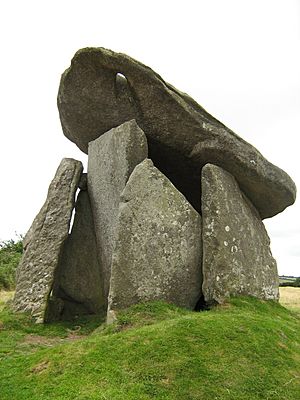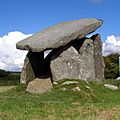Trethevy Quoit facts for kids

Trethevy Quoit viewed from the northwest
|
|
| Location | St Cleer, Cornwall |
|---|---|
| Coordinates | 50°29′35″N 4°27′20″W / 50.4931814°N 4.4554281°W |
| Type | Dolmen |
| History | |
| Periods | Neolithic |
| Site notes | |
| Ownership | Cornwall Heritage Trust |
| Public access | Yes |
Trethevy Quoit (Cornish: Koyt Tredhewi) is a very old stone structure in Cornwall, United Kingdom. It is a type of tomb made from huge stones, called a megalithic tomb. People in the area sometimes call it "the giant's house" because it is so big.
This ancient monument stands about 9 feet (2.7 meters) tall. It has five large stones standing upright, with a huge flat stone resting on top. In 2017, it was added to a list of important places that need protection.
Contents
Where to Find Trethevy Quoit
Trethevy Quoit is located in a small area called Tremar Coombe. This is north of the town of Liskeard in Cornwall. A historic farmhouse, Trethevy farmhouse, is also nearby.
Not far from the Quoit, you can find The Hurlers. These are three ancient stone circles. They were built much later, during the late Bronze Age. The Cornwall Heritage Trust looks after Trethevy Quoit. They do this for English Heritage, which protects historic sites.
How Trethevy Quoit Was Built
Trethevy Quoit is a type of tomb called a portal tomb. Originally, a large mound of earth covered the entire structure. This mound was about 6.5 meters (21 feet) wide.
Inside the mound were seven large stones and a huge capstone. The capstone is the flat stone on top. It is 3.7 meters (12 feet) long and weighs about 10.5 tons. There is a natural hole in the top of the capstone. Some people think this hole might have been used to watch the stars.
The tomb has a back stone, two side stones, and a front stone. There is also a stone next to the front stone. A special part of these Cornish tombs is a small, partly closed area in front of the main entrance. Some stones even have small holes as decoration.
The front stone is often called an entrance stone. At Trethevy Quoit, a small rectangular stone at the bottom right of the front can be moved. This is rare for these types of tombs. It allows a small opening into the burial chamber.
The back wall of the chamber has fallen inward over time. If this stone stood upright, it would have been as tall as the front stone. This would have made the capstone rest almost flat on the front and back walls. However, there would have been gaps, letting soil into the chamber. It is likely that the back wall collapsing damaged the side stones.
In November 2017, Trethevy Quoit was put on the Heritage at Risk Register. This was because of damage from fences and animals like livestock. Their movement was causing the ground around the stones to wear away.
Learning About Trethevy Quoit
The first time Trethevy Quoit was written about was in 1584. John Norden mentioned it in his book about Britain. However, his book was not published until 1728.
In the 1800s, a person named William Copeland Borlase studied the site. He drew pictures of it and guessed how it might have looked long ago. He thought the back wall had fallen over.
Later, in 1932, Hencken wrote a new explanation of the site. He talked about the special front area of the tomb. He also saw similar structures in Brittany, France.
Recent digs have shown that these types of stone tombs were built during the Neolithic period. This was between 3700 and 3500 BC. These large stone tombs were used by communities for a very long time as burial places.
Images for kids





